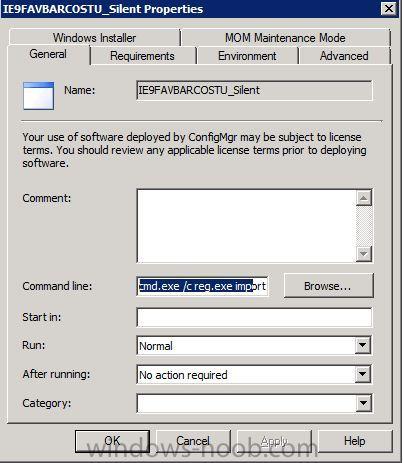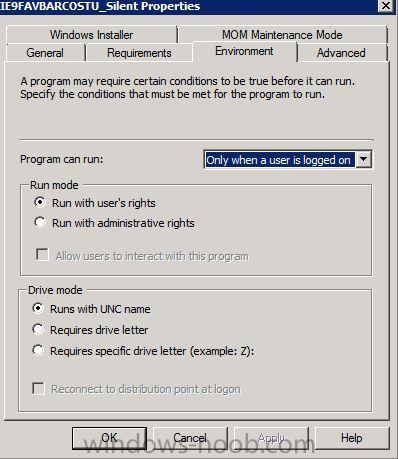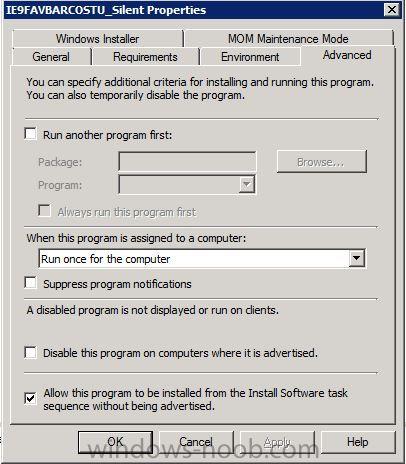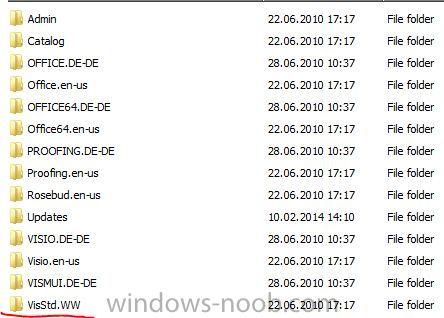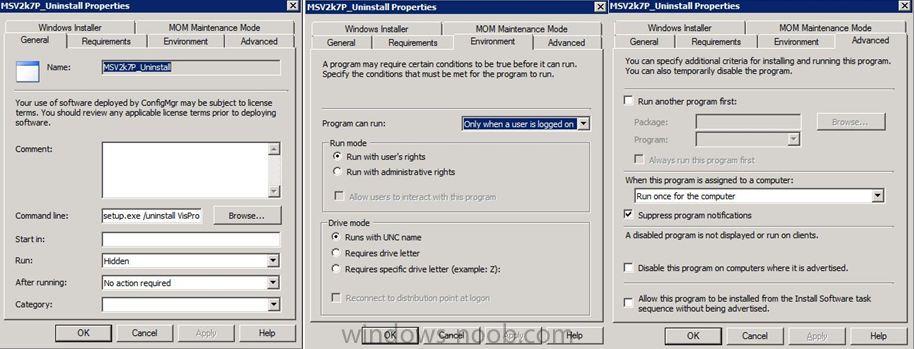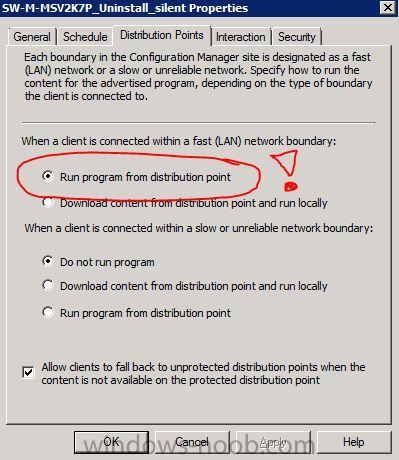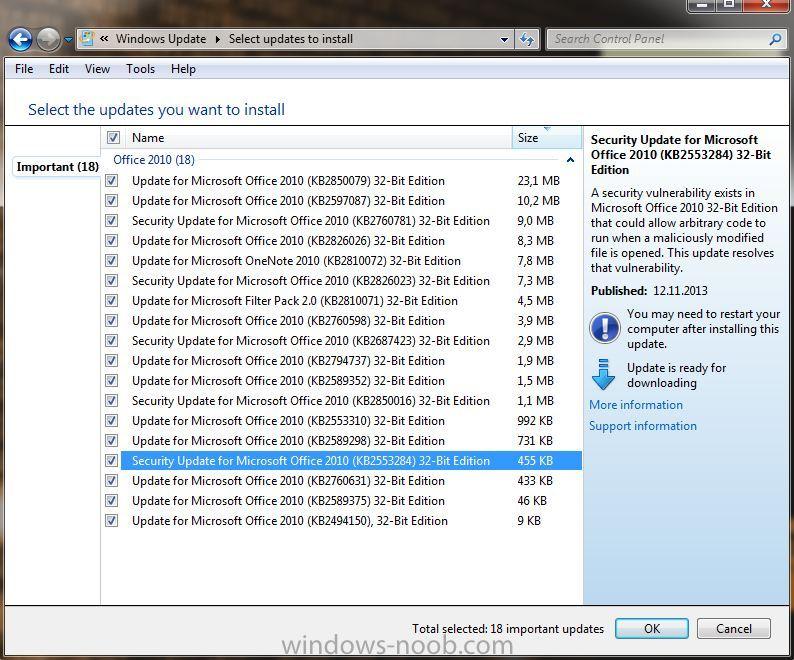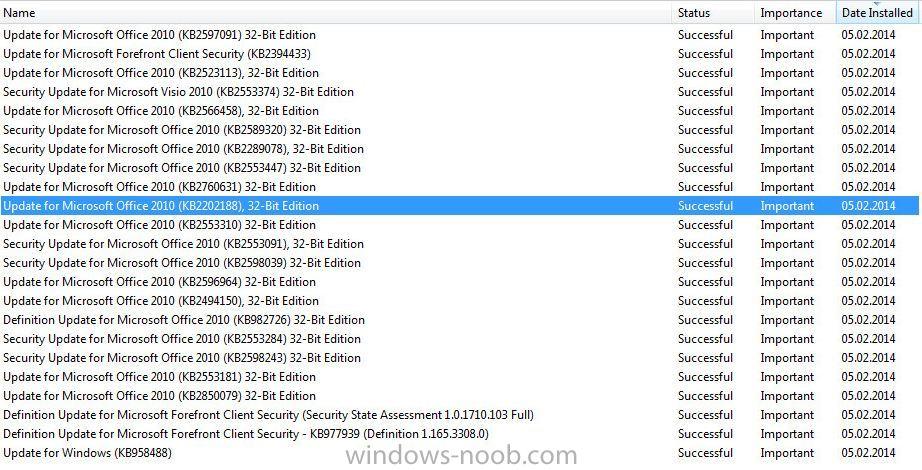-
Posts
79 -
Joined
-
Last visited
-
Days Won
2
Everything posted by Atomic12
-

SCCM Departments in a company planning and design
Atomic12 replied to Atomic12's topic in Configuration Manager 2012
Hi, great point! Thank you, we use MDT 2010 in this moment, so I will for surely use MDT 2013 (already installed it and tried it out) but still have some question. So if you choose departments in MDT Task sequence, how do i proceed after that? Do i just build normal TS in SCCM and it "takes" information from MDT TS? If answer is yes then I don't know why we used HTA script in the first place, but that was another person managing the SCCM part in our company. By roles you mean? Sorry still a noob when it comes to setting up the whole infrastructure... -

SCCM Departments in a company planning and design
Atomic12 replied to Atomic12's topic in Configuration Manager 2012
Hi, thank you for you answer. 1. Yes, every computer object is its own OU, for example we have sales OU and isnside that OU another OU called computerSALES. We have this for every department. 2. We support unknown computer. I thought that could be the case what you described but I always complicate things. Just for my info are there any other ways to do it? br, -
Hi, first I apologize if there is a topic with same issue. We are in a middle of a upgrade from SCCM 2007 to 2012 version and I have no idea how to implement the solution to deploy specific applications to specific department. In SCCM 2007 we use the HTA script which does its job fair but i would like to move away from this solution. So in my company we have couple of departments like: project management, IT, quality assurance, development... and I need a solution which installs OS, drivers, set of default applications (Skype, adobe reader, TeamViewer) and then according to the department special applications need by that department. The only way i can think of is Task sequence for every department. I kindly ask someone to share in detail how to do it, maybe there is a guide somewhere but I could not find it. Thank you all,
-
Hi, I have deployed Adobe in my company, but without any customizations. Downloaded the file, renamed it to AR11EN.exe and made a simple batch script with only one line: AR11EN.exe /sAll
-

How can I change a HKCU setting within Windows during an OSD deployment
Atomic12 replied to roshanbhavsar04's question in How do I ?
This step for me did not work with that command line, I kept on getting the 0x0000001 task sequence error. "in the next step we import the Registry file in another Run Command Line step this Registry file can be a file in a package. cmd.exe /c reg.exe import "Userprefs.reg" but what is now working is: regedit /s "NameOfYourRegFile.reg" -

Customization of Internet Explorer 9 (HKCU key!) problems
Atomic12 replied to Atomic12's topic in Configuration Manager 2007
Yup, thanks, Now I got it finally: This refers: To this: I was doing your steps all in CMD! At least I know that I am a noob on a windows-noob forum Now when I came across this "discovery" I will try both options.- 18 replies
-
- HKCU
- Customization
-
(and 2 more)
Tagged with:
-

Customization of Internet Explorer 9 (HKCU key!) problems
Atomic12 replied to Atomic12's topic in Configuration Manager 2007
Ok, your last sentence is what I am missing, so I did not "open" the defuser path in the task sequence. I like you solution to solve it with advertisment, I will test it today and let you know the results. BIG THANK YOU FOR A VIDEO TUTORIAL!- 18 replies
-
- HKCU
- Customization
-
(and 2 more)
Tagged with:
-

Customization of Internet Explorer 9 (HKCU key!) problems
Atomic12 replied to Atomic12's topic in Configuration Manager 2007
Thank you so much!- 18 replies
-
- HKCU
- Customization
-
(and 2 more)
Tagged with:
-

Customization of Internet Explorer 9 (HKCU key!) problems
Atomic12 replied to Atomic12's topic in Configuration Manager 2007
Via package...- 18 replies
-
- HKCU
- Customization
-
(and 2 more)
Tagged with:
-

Customization of Internet Explorer 9 (HKCU key!) problems
Atomic12 replied to Atomic12's topic in Configuration Manager 2007
Hi, thanks for your answer. Guess the language barrier is coming into play I am missing the part on how to implement it to sccm? How do I keep the defuser path open? Because when I use this: Windows Registry Editor Version 5.00 [HKEY_LOCAL_MACHINE\Software\Microsoft\Internet Explorer\MINIE] "TabBandWidth"=dword:000001a8 "LinksBandEnabled"=dword:00000001 "AlwaysShowMenus"=dword:00000001 It does not apply. As i stated before I use the HKEY_LOCAL_MACHINE\defuser\Software\Microsoft\Internet Explorer\MINIE the i get the error message: Hope you understand it. Thank you for spending your time with me and this issue.- 18 replies
-
- HKCU
- Customization
-
(and 2 more)
Tagged with:
-

Customization of Internet Explorer 9 (HKCU key!) problems
Atomic12 replied to Atomic12's topic in Configuration Manager 2007
Niall?- 18 replies
-
- HKCU
- Customization
-
(and 2 more)
Tagged with:
-

Customization of Internet Explorer 9 (HKCU key!) problems
Atomic12 replied to Atomic12's topic in Configuration Manager 2007
Ok, following your guide it worked yesterday, but something was bugging me so i decided to start all over again to recreate it and today i am facing the same problem. Your guide works that is without a question, but I am missing the part after you unload the defuser hive. Which part of the registry do I export? You know what I mean? If you import your settings in one .reg file, you unload the hive - ok but where is the saving the settings/exporting that specifice key in registry so i can apply it with the package? I AM MISSING THE PART HOW TO INTEGRATE THIS INTO A PACKAGE. I am reading your posts over and over, trying to understand but it does not work Thanks,- 18 replies
-
- HKCU
- Customization
-
(and 2 more)
Tagged with:
-

Customization of Internet Explorer 9 (HKCU key!) problems
Atomic12 replied to Atomic12's topic in Configuration Manager 2007
Hi, the solution does not work for me. I am doing something wrong, so here is how I do it: 1. Go to my test virtual machine and run your first command: cmd.exe /c reg.exe load HKEY_LOCAL_MACHINE\defuser c:\users\default\ntuser.dat 2. I run your second command: cmd.exe /c reg.exe import "ie9.reg" and ie9.reg file looks like this: Windows Registry Editor Version 5.00 [HKEY_LOCAL_MACHINE\Defuser\Software\Microsoft\Internet Explorer\MINIE] "TabBandWidth"=dword:000001a8 "LinksBandEnabled"=dword:00000001 "AlwaysShowMenus"=dword:00000001 As you can see I have manually changed the hkcu with hklm key like you told our other college to do. I must admit that I don't understand this line: "the important thing here is that the registry file refers to the mountpoint referenced in our first step, below is an example of that" I hope that you are reffering that whatever we are importing that it must contain the hklm key. 3. Then I execute the last command: cmd.exe /c reg.exe unload HKEY_LOCAL_MACHINE\defuser Under all command I get the "operation completed successfully". I have made a software collection and advertised it but when I get the advertisement nothing happens, I am logged as a user (with admin rights). However when I double-click on the ie9.reg file I get the "Cannot import C:\ie9.reg: Error accessing the registry" - that part of the registry is exported so I don't see it as corrupted. I am doing this double click only to test it but it looks like changing the hkcu with hklm is the problem because when I change it back to hkcu it works without any errors. Is the command line cmd.exe /c reg.exe import "ie9" correct/valid? Thanks,- 18 replies
-
- HKCU
- Customization
-
(and 2 more)
Tagged with:
-

Customization of Internet Explorer 9 (HKCU key!) problems
Atomic12 replied to Atomic12's topic in Configuration Manager 2007
Hi, tried that one, as I have stated above in my first post but did not have any success. How hard can this be? would it be to much if i ask you for a tutorial? I want to deployed it as a package, not over TS. I know you are busy but it would help a lot. As i stated: Windows Registry Editor Version 5.00 [HKEY_LOCAL_MACHINE\Defuser\Software\Microsoft\Internet Explorer\MINIE] "LinksBandEnabled"=dword:00000001 Thanks,- 18 replies
-
- HKCU
- Customization
-
(and 2 more)
Tagged with:
-

Customization of Internet Explorer 9 (HKCU key!) problems
Atomic12 replied to Atomic12's topic in Configuration Manager 2007
Comon guys, please help! 60 views not one answer?- 18 replies
-
- HKCU
- Customization
-
(and 2 more)
Tagged with:
-
Hi guys, Having major problems with a "simple" thing - wanting to have an Internet Explorer 9 favorites bar shown after deployment is finished on the client. Tried many things, read many posts regarding this issue and I still cannot get it to work. http://www.itninja.com/question/sccm-add-hkcu-key-to-all-new-users This link is exactly what I need but no conclusion, unfortunately The way I do it and fail: 1. Create a package in SCCM 2007. 2. Run both with admin and user rights to see if it works. 3. Tried couple of command line options: regedit /s IE9ShowFav.reg regedit /s ./IE9ShowFav.reg regedits /s "%~dp0IE9ShowFav.reg" cmd.exe /c reg.exe import "IE9ShowFav.reg 4. Run a batch script which copies the IE9ShowFav.reg file to C:\temp and then regedit /s: @echo off md "C:\temp" xcopy "%~dp0IE9ShowFav.reg" "C:\temp" regedit /s "%~dp0IE9ShowFav.reg" exit 5. Reg key looks like this: 1st version: Windows Registry Editor Version 5.00 [HKEY_CURRENT_USER\Software\Microsoft\Internet Explorer\MINIE] "TabBandWidth"=dword:000001a8 "LinksBandEnabled"=dword:00000001 "AlwaysShowMenus"=dword:00000001 After reading this post and understanding very little: http://www.windows-noob.com/forums/index.php?/topic/7772-how-can-i-change-a-hkcu-setting-within-windows-during-an-osd-deployment/ changed the HKCU with HKLM then ran with admin rights - no succes 2nd version: Windows Registry Editor Version 5.00 [HKEY_LOCAL_MACHINE\Defuser\Software\Microsoft\Internet Explorer\MINIE] "TabBandWidth"=dword:000001a8 "LinksBandEnabled"=dword:00000001 "AlwaysShowMenus"=dword:00000001 Nothing works! What I read I know that it should be run with user rights since it is being done for a current user. Can somebody explain to me this in detail? We use HTA script and this is just another package in the list that needs to be installed, do I need to do it under TS? What would be the procedure for only one user? or for all? it is the same to me but I want to know how it works. Links: http://www.itninja.com/question/sccm-add-hkcu-key-to-all-new-users http://www.autoitscript.com/forum/topic/160063-regread-not-working-from-sccm-script-running-as-current-user/ http://www.networksteve.com/enterprise/topic.php/distributing_a_registry_key_with_SCCM_2007_SP2/?TopicId=27980&Posts=0 Thanks,
- 18 replies
-
- HKCU
- Customization
-
(and 2 more)
Tagged with:
-
Hi, the process for uninstallation for ALL Office, Visio and Project versions (2007 and 2010) would go like this: create a new .xml file named: "SilentUninstallConfig.xml" and save it in your installation folder or where you want. Populate the file with: <Configuration Product="APPLICATIONID"> <Display Level="none" CompletionNotice="no" SuppressModal="yes" AcceptEula="yes" /> <Setting Id="SETUP_REBOOT" Value="Never" /> </Configuration> ____________________________________________________________________________ Replace the APPLICATIONID inside of " " with correct product id: Visio 2007 Standard: "VisStd" Visio 2007 Professional: "VisPro" Visio 2010 Professional: "Visio" ! (important: in 2010 version there is no VisPro, only Visio product id!) Project 2007 Standard: "PrjStd" Project 2010 Professional: "PrjPro" Office 2007 Standard: "Standard" Office 2007 Enterprise: "Enterprise" Office 2010 Professional: "ProPlus" Example: VISIO 2007 PROFESSIONAL: <Configuration Product="VisPro"> <Display Level="none" CompletionNotice="no" SuppressModal="yes" AcceptEula="yes" /> <Setting Id="SETUP_REBOOT" Value="Never" /> </Configuration> Second part is the command prompt order which goes like this: CMD: setup.exe /uninstall APPLICATION ID /config SilentUninstallConfig.xml AGAIN: replace the APPLICATION ID with the correct variable from examples shown above. P.S. You can find the product id from Microsoft's products in the XYZ.WW folder: CREATE A NEW PROGRAM IN SCCM 2007: ADD DISTRIBUTION POINT MAKE ADVERTISEMENT Important: In my case it did not work with the option of running the program with the DP, what worked was "Download content from DP and run locally", that means that it has to download 500 mb+ of data to every machine. Not the very best idea but that is how it works. Hints that will save you some nerves: 1. Be patient it can take up to 20-30min until you see the results on your test machine. SCCM 2007 is slow and somethimes buggy + it has to download xyz amount of data to the client. 2. In my case when you create a program it runs with both admin and user rights (user has to be local admin on the machine). 3. Ensure that there are not windows updates pending! very important! Advertisement will fail until client is free from windows updates. 4. Folder in Windows\SysWOW64\CCM\Cache is your friend, you can see there when the package is being downloaded. If for any reason package is already there but no results you have to delete that package otherwise advertisement will not download again! Tttt that's all folks! Open to suggestions how to make the process more efficient.
-
- Office
- Uninstall Office
- (and 8 more)
-

Deploying Adobe Reader 11.0.06
Atomic12 replied to sothpaw's question in Deploy software, applications and drivers
We are using SCCM 2007, and when I tried to update the TS to use .06 version it always got stucked for some reason. I tried downloading it again suspecting that it was maybe a corrupted file, then when it did not want to work I just let it stay on .03 version. Could be that the 06.version is buggy in some way. -

MS Office 2010 sp2 updates still showing
Atomic12 replied to Atomic12's topic in Configuration Manager 2007
Hi, thanks for you answer, it includes the updates above. The only "solution" is to install visio first then office, after that order i get about 10-15 updates which is more acceptable.- 3 replies
-
- office 2010
- updates
-
(and 2 more)
Tagged with:
-

MS Office 2010 sp2 updates still showing
Atomic12 replied to Atomic12's topic in Configuration Manager 2007
I have isolated the problem to be the installation of Visio 2010 which is installed for our department in the company, and Visio even if it is patched is bringing this updates with it. If i cannot make it work today I will open a support case with MS. I have isolated the problem to be the installation of Visio 2010 which is installed for our department in the company, and Visio even if it is patched is bringing this updates with it. If i cannot make it work today I will open a support case with MS. edit: after I installed completely patched and updated Visio I still get this: Office 2010 is not installed in this moment. I am trying reverse option, first Visio than Office.- 3 replies
-
- office 2010
- updates
-
(and 2 more)
Tagged with:
-
Hi guys, I have been struggling with this problem since last week. I want to update all of our MS Office Versions with the latest updates so that i get as little updates as possible. I have already done new Windows 7 image, it works perfectly. But after downloading all of the updates manually (before I found a very useful script which collects those updates) for office and unpacked them to updates folder. But after deployment of our image and office 2010 i still get 20 updates like in the picture attached bellow. DP are updated, everything seems fine, we also install Visio 2010 so i updated Visio as well. But i again get 20 updates. I have tried installing the patched office 2010 on my non production VM, and it gets only 5 updates and that is ok, because we are then talking about 10mb's worth of updates. We have German version of Office with English language pack, could that be the problem? I should mention that we dont use WSUS with SCCM 2007 (dont ask why i am not in charge ) Useful vbs script for collecting exactly installed updates: Dim oMsi,oFso,oWShell Dim Patches,SumInfo Dim patch,record,msp Dim qView Dim sTargetFolder,sMessage Const OFFICEID = "000-0000000FF1CE}" Const PRODUCTCODE_EMPTY = "" Const MACHINESID = "" Const MSIINSTALLCONTEXT_MACHINE = 4 Const MSIPATCHSTATE_APPLIED = 1 Const MSIOPENDATABASEMODE_PATCHFILE = 32 Const PID_SUBJECT = 3 'Displayname Const PID_TEMPLATES = 7 'PatchTargets Set oMsi = CreateObject("WindowsInstaller.Installer") Set oFso = CreateObject("Scripting.FileSystemObject") Set oWShell = CreateObject("Wscript.Shell") 'Create the target folder sTargetFolder = oWShell.ExpandEnvironmentStrings("%TEMP%")&"\Updates" If Not oFso.FolderExists(sTargetFolder) Then oFso.CreateFolder sTargetFolder sMessage = "Patches are being copied to the %Temp%\Updates folder." & vbCrLf & "A Windows Explorer window will open after the script has run." oWShell.Popup sMessage,20,"Office Patch Collector" 'Get all applied patches Set Patches = oMsi.PatchesEx(PRODUCTCODE_EMPTY,MACHINESID,MSIINSTALLCONTEXT_MACHINE,MSIPATCHSTATE_APPLIED) On Error Resume Next 'Enum the patches For Each patch in Patches If Not Err = 0 Then Err.Clear 'Connect to the patch file Set msp = oMsi.OpenDatabase(patch.PatchProperty("LocalPackage"),MSIOPENDATABASEMODE_PATCHFILE) Set SumInfo = msp.SummaryInformation If Err = 0 Then If InStr(SumInfo.Property(PID_TEMPLATES),OFFICEID)>0 Then 'Get the original patch name Set qView = msp.OpenView("SELECT `Property`,`Value` FROM MsiPatchMetadata WHERE `Property`='StdPackageName'") qView.Execute : Set record = qView.Fetch() 'Copy and rename the patch to the original file name oFso.CopyFile patch.PatchProperty("LocalPackage"),sTargetFolder&"\"&record.StringData(2),TRUE End If End If 'Err = 0 Next 'patch oWShell.Run "explorer /e,"&chr(34)&sTargetFolder&chr(34) ______________________________________________________ If I have left any important info please let me know. Thanks,
- 3 replies
-
- office 2010
- updates
-
(and 2 more)
Tagged with:
-
Hi, this is an old topic, but I would like to answer it for the future generations . I ran into the same problem and I use a VM to test the new images and since you always install/reinstall somehow the volume gets corrupted so the solution is to run chkdsk utility but INSIDE of the in my case VM or on your test machine. So F8 to get into the VM (for the vSphere client!) run "chkdsk c: /f" and watch how the magic happens. Hope this helps, Cheers,
-
Hi, here is a small guide so other people don' have to loose their time google-ing like I did today. I got a task to deploy some additional fonts during the deplyoment of notebooks in my company. I did it like this: __________________________________________________ @Echo Off robocopy %~dp0. "C:\Windows\Fonts" /xf "fontscopy.bat" /SEC regedit /s fonts.reg __________________________________________________ fonts.reg file is necessary to register new fonts in registry although I must admit I this example it works without this file It looks like this: _______________________________________________________________________ Windows Registry Editor Version 5.00 [HKEY_LOCAL_MACHINE\SOFTWARE\Microsoft\Windows NT\CurrentVersion\Fonts] "3of9 (TrueType)"="3of9.ttf" .... ________________________________________________________________________ +5 more fonts, important to point out that the first part of the file before (TrueType) so that means 3of9 is the name YOU give to the font and its visible to apps in windows, the part after "3of9.ttf" is the file name itself. I will break down the robocopy command for explanation: robocopy %~dp0. "C:\Windows\Fonts" /xf "fonts.reg" "test.bat" /SEC %~dp0 = go to the drive letter and path of the running batch file aka you need it for copying files over network - VERY IMPORTANT, IT WON'T WORK WITHOUT THIS ONE. . = copy all files inside the folder (.bat must be inside of the folder you want to copy). /xl = exclude files from copying (must be inside "" for example "fontscopy.bat"). /SEC = robocopy will copy files even if they are in a protected folder like Windows\Fonts folder is. Since I am a noob on this windows-noob forum all suggestions are welcome. In this moment I do things the way I know and that is simple but it is working.
-
- 1
-

-
- fonts
- deployment
- (and 7 more)
-

Customization in Default user profile during deployment
Atomic12 replied to Atomic12's topic in Configuration Manager 2007
Hi, you mean in the task sequence? I know that we have our deparment organized by one HTA script, and I have put it in core applications so every college gets it, after that step you get special SW according to your department (sales, QA, marketing...). Important thing is that it works. Thanks,- 5 replies
-
- Default
- default user
-
(and 4 more)
Tagged with:
-

Customization in Default user profile during deployment
Atomic12 replied to Atomic12's topic in Configuration Manager 2007
Hi, sorry for the late answer, i forgot about this topic and went for holidays @jorgen: We are using windows 7 yes, and no we didnt use the unattended.xml file. I made a simple script which looks like this: @echo off md C:\Users\Default\AppData\Local\Microsoft\Office copy "%~dp0Word.qat" C:\Users\Default\AppData\Local\Microsoft\Office copy "%~dp0Excel.qat" C:\Users\Default\AppData\Local\Microsoft\Office copy "%~dp0PowerPoint.qat" C:\Users\Default\AppData\Local\Microsoft\Office copy "%~dp0Word.officeUI" C:\Users\Default\AppData\Local\Microsoft\Office copy "%~dp0Excel.officeUI" C:\Users\Default\AppData\Local\Microsoft\Office copy "%~dp0PowerPoint.officeUI" C:\Users\Default\AppData\Local\Microsoft\Office Simple making of the "Office" directory in the Default profile and then copying the .qat's to that directory. The solution works only after a new user has logged into the system, so it won't show up in administrator account for example. Thanks,- 5 replies
-
- Default
- default user
-
(and 4 more)
Tagged with:






